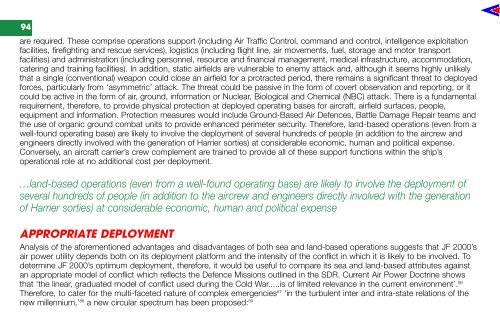THE RAF AIR POWER REVIEW - Royal Air Force Centre for Air ...
THE RAF AIR POWER REVIEW - Royal Air Force Centre for Air ...
THE RAF AIR POWER REVIEW - Royal Air Force Centre for Air ...
You also want an ePaper? Increase the reach of your titles
YUMPU automatically turns print PDFs into web optimized ePapers that Google loves.
94<br />
are required. These comprise operations support (including <strong>Air</strong> Traffic Control, command and control, intelligence exploitation<br />
facilities, firefighting and rescue services), logistics (including flight line, air movements, fuel, storage and motor transport<br />
facilities) and administration (including personnel, resource and financial management, medical infrastructure, accommodation,<br />
catering and training facilities). In addition, static airfields are vulnerable to enemy attack and, although it seems highly unlikely<br />
that a single (conventional) weapon could close an airfield <strong>for</strong> a protracted period, there remains a significant threat to deployed<br />
<strong>for</strong>ces, particularly from ‘asymmetric’ attack. The threat could be passive in the <strong>for</strong>m of covert observation and reporting, or it<br />
could be active in the <strong>for</strong>m of air, ground, in<strong>for</strong>mation or Nuclear, Biological and Chemical (NBC) attack. There is a fundamental<br />
requirement, there<strong>for</strong>e, to provide physical protection at deployed operating bases <strong>for</strong> aircraft, airfield surfaces, people,<br />
equipment and in<strong>for</strong>mation. Protection measures would include Ground-Based <strong>Air</strong> Defences, Battle Damage Repair teams and<br />
the use of organic ground combat units to provide enhanced perimeter security. There<strong>for</strong>e, land-based operations (even from a<br />
well-found operating base) are likely to involve the deployment of several hundreds of people (in addition to the aircrew and<br />
engineers directly involved with the generation of Harrier sorties) at considerable economic, human and political expense.<br />
Conversely, an aircraft carrier’s crew complement are trained to provide all of these support functions within the ship’s<br />
operational role at no additional cost per deployment.<br />
…land-based operations (even from a well-found operating base) are likely to involve the deployment of<br />
several hundreds of people (in addition to the aircrew and engineers directly involved with the generation<br />
of Harrier sorties) at considerable economic, human and political expense<br />
APPROPRIATE DEPLOYMENT<br />
Analysis of the a<strong>for</strong>ementioned advantages and disadvantages of both sea and land-based operations suggests that JF 2000’s<br />
air power utility depends both on its deployment plat<strong>for</strong>m and the intensity of the conflict in which it is likely to be involved. To<br />
determine JF 2000’s optimum deployment, there<strong>for</strong>e, it would be useful to compare its sea and land-based attributes against<br />
an appropriate model of conflict which reflects the Defence Missions outlined in the SDR. Current <strong>Air</strong> Power Doctrine shows<br />
that ‘the linear, graduated model of conflict used during the Cold War.....is of limited relevance in the current environment’. 86<br />
There<strong>for</strong>e, to cater <strong>for</strong> the multi-faceted nature of complex emergencies 87 ‘in the turbulent inter and intra-state relations of the<br />
new millennium,’ 88 a new circular spectrum has been proposed: 89

















